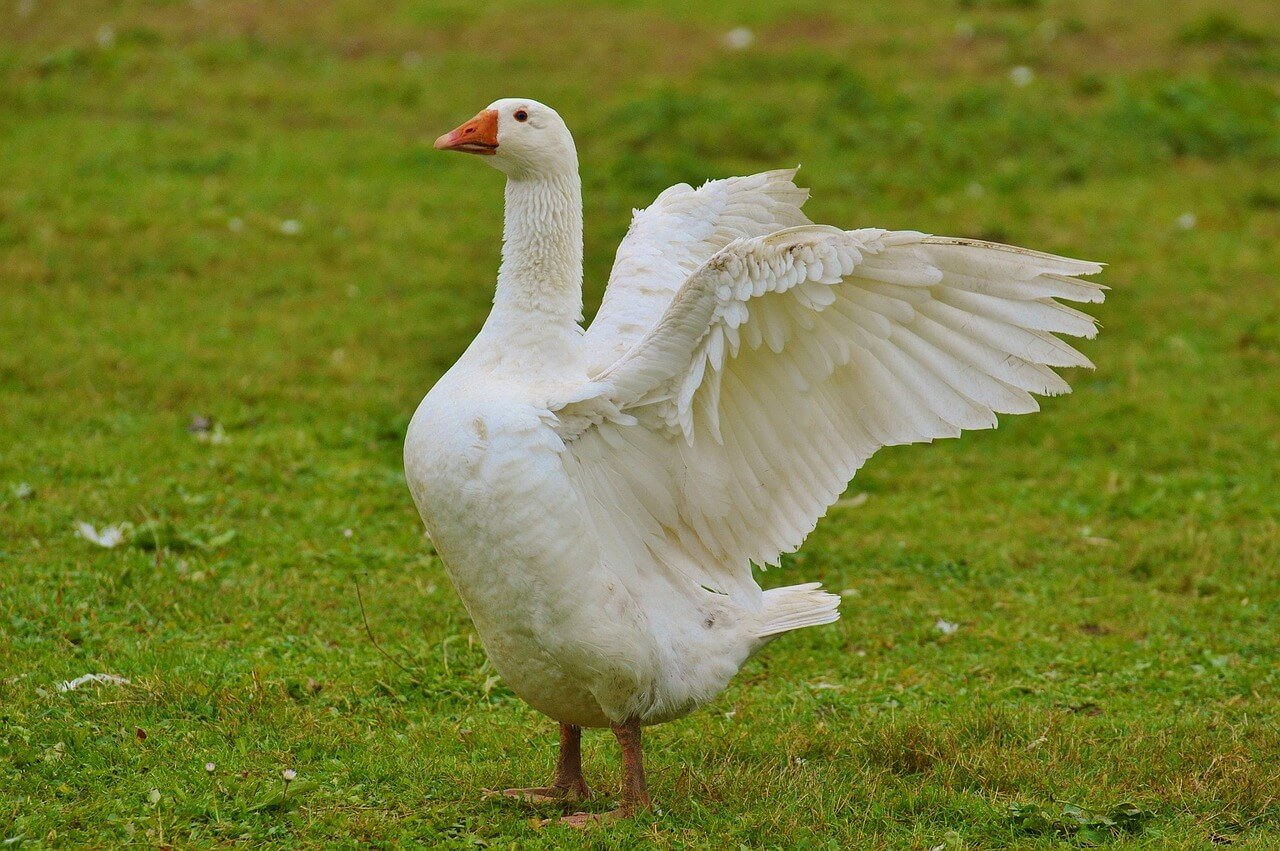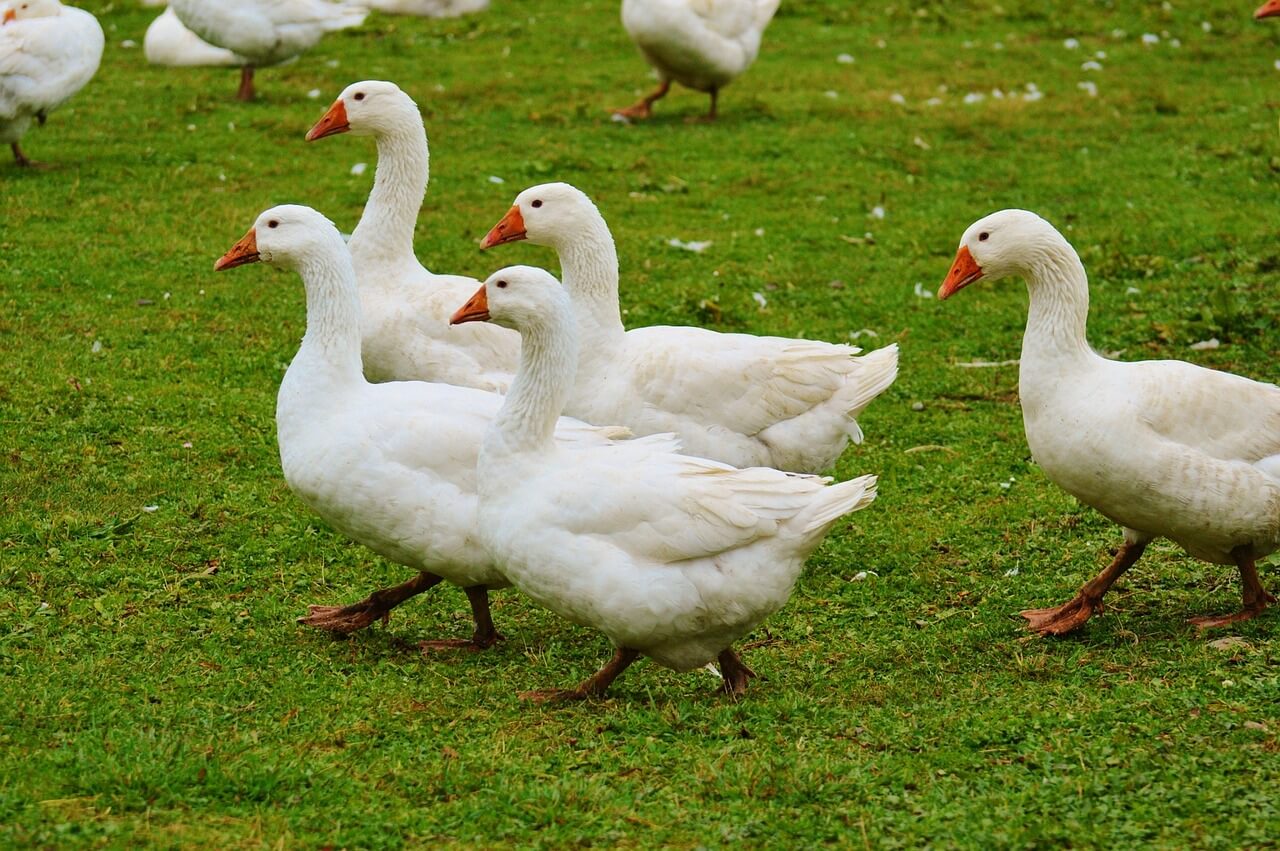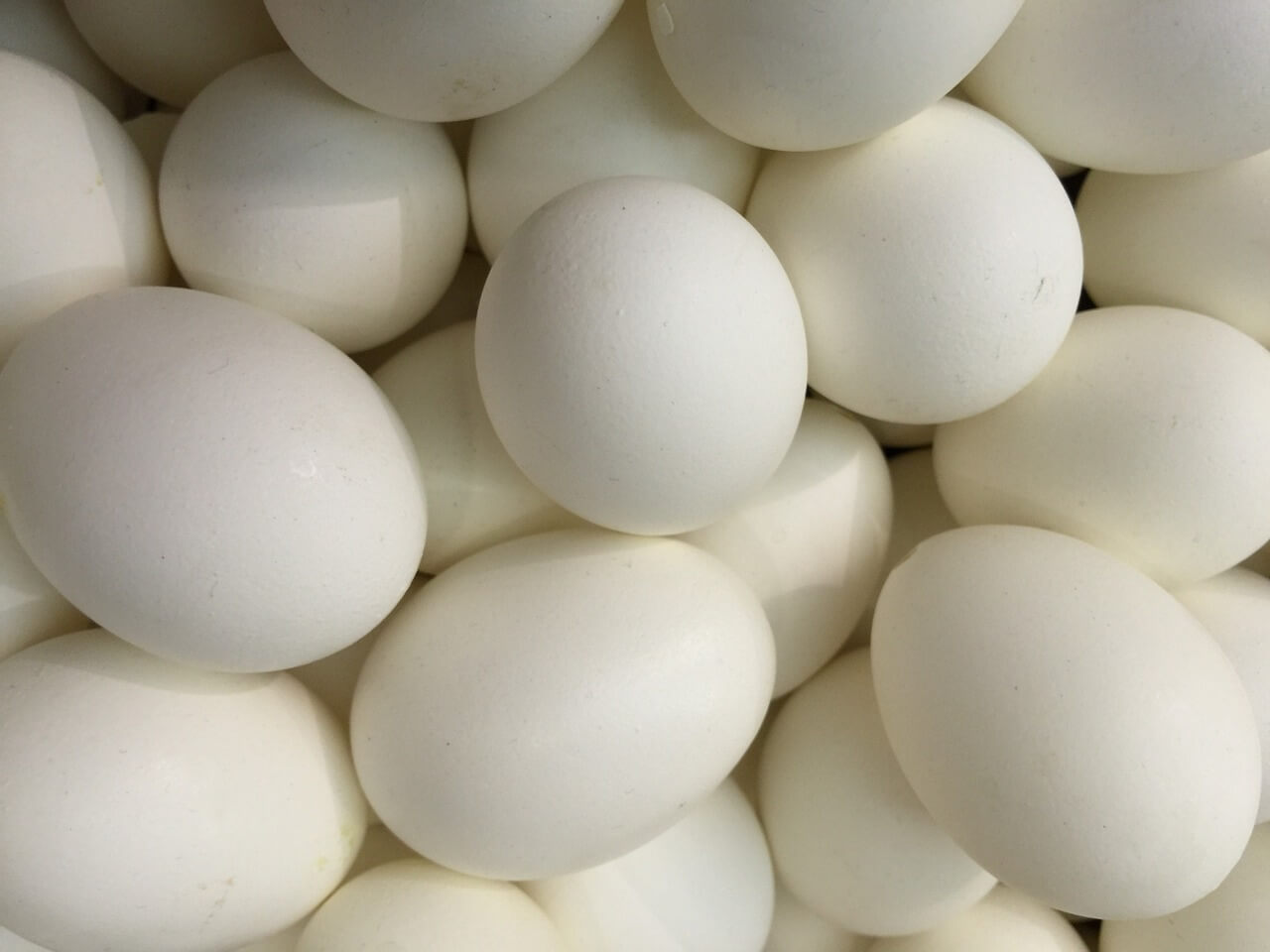A goose will only sit on her eggs if she is ready to brood them. Young geese in their first year often start brooding but give up before any eggs can hatch. Geese that are two years of age generally make much more reliable mothers. This is why your goose may not be sitting on her eggs.
What You'll Learn Today
Do Geese Leave Their Eggs Unattended?

Yes, broody geese do leave their eggs so they can eat, drink and bathe. It is normal behavior for them to do this for up to an hour a day.
It’s actually really important your broody goose does leave her nest for her own wellbeing. Also, when she bathes, she brings back moisture to the nest on her feathers, which creates the correct humidity level necessary for the eggs to hatch properly.
Sometimes young geese, who have become broody for the first time, refuse to leave their nest. This is very dangerous for the goose, as without eating and drinking, she may die in the nest.
If you have a goose who refuses to leave her nest, you will have to force her off each day. You may need to lift her off, being careful her feet don’t break the eggs. Older geese are usually much better at coming off the nest each day than younger ones.
When you check your goose and her eggs, try to feel her weight and ensure she isn’t getting too thin. If absolutely necessary, you can finish off the eggs in an incubator or under a broody Muscovy duck.
How Do You Get a Goose to Sit On Eggs?

You can’t force a goose to sit on eggs, but you can encourage her to do so by providing a really inviting nesting area. Give her a good deep bed of shavings somewhere quiet, and protected.
A large broody coop (nesting box) made just for the job of brooding, is the best option. It is essentially a goose house made for one. Goose like to feel safe when they are brooding eggs, so avoid the goose being able to look outside from the nest box.
By replacing any eggs your goose lays with replicas (I use blown goose eggs filled with plaster of Paris), you can fool her into thinking she has a full clutch. When she starts to brood, simply replace the “fake” eggs with some of the real ones you’ve been collecting.
How Long Does a Goose Sit On Eggs Before They Hatch?
The normal incubation period for a goose varies from 28 to 35 days. Even if you use an incubator, the time can still be very varied but from my own experience, most hatch around day 32.
When eggs begin hatching, it can take 2 or 3 days before all of the goslings fully emerge from their shells. While they hatch out, the mother goose will chatter to her babies and keep them safe and warm under her for a few more days.
Eventually, the goslings will start coming out to view the world, and after a while, the goose will abandon the nest and any unhatched eggs. The goose then takes her young to food and water.
It is usual for the gander to also take responsibility for the brood and often, the mother goose will leave her goslings solely in his charge.
In this video, some of the signs that a goose is nesting are shown so you know what to look for.
How Many Eggs Does a Goose Lay Before She Sits On Them?
There is no firm number of eggs the goose will lay before she starts to sit on them, but generally, it is around 6 to 10.
I have seen a goose trying to sit on much larger numbers than this, but the problem is that some of the eggs are already likely to be dead, and the eggs on the outside get cold, so you will gradually lose more and more viable eggs.
For this reason, it is better to restrict the number of eggs to a maximum of 10.
As soon as your goose starts to sit on her eggs, it’s a good idea to worm her. This is because worms can take hold of a goose as she becomes run down. It will also help protect the goslings when they are born, as gizzard worms can kill them.
Another problem with broody geese is that when one goes broody, often, another one will too. Sometimes they try to brood the same nest, which will be a disaster, so ensure a second broody goose is removed and kept away from the first.
How to Hatch Goose Eggs

Goose eggs can be hatched naturally using a broody goose or by using an incubator. Muscovy ducks are also useful to hatch goose eggs and make very reliable sitters and mothers.
After laying, a goose egg can remain viable for around 7 to 10 days. After this time, the chances of hatching the egg successfully begin to diminish significantly with each passing day.
To hatch goose eggs using an incubator you need to ensure it is set up correctly:
1. Temperature
The temperature of your incubator for hatching goose eggs needs to be at 99.5°F. Unlike other poultry that may require the temperature to be changed at different periods during incubation, this is not the case with goose eggs, and a constant temperature can be maintained.
2. Humidity
Humidity levels for hatching geese eggs are quite specific – For the first 27 days, you require the humidity to be between 50 and 55%. After this, raise the humidity to 75% for the remainder of the time.
Maintaining the correct humidity can be done by taking the eggs out each day and spraying them all over with a mist of warm water before replacing them back in the incubator. This also mimics the natural way a mother would leave her nest every day.
Some people submerge the eggs in water that is heated to 99.5°F for one minute every other day from day 15 of incubation and then daily in the final week until just prior to hatching.
3. Prepping Your Incubator
Every incubator has its own specific setup process. Usually, you will need to set it to the correct temperature from 24 to 48 hours before placing the eggs inside. This allows for the temperature and humidity to become stable.
When storing your eggs, before placing them into the incubator, it is best to keep them somewhere cool between 59°F to 60°F. They will need to be kept in a horizontal position and turned daily.
Select the best eggs by making sure they have no cracks and are a good weight, between 5 and 7 ounces. Dirty eggs can be cleaned with a damp cloth, this is important as dirt can cause disease and inhibit candling.
4. Placement in the Incubator
French studies have shown that the best way of placing goose eggs in an incubator isn’t on their fat ends as you would do with eggs from other poultry, but by lying them down on their side horizontally.
5. Turning
With goose eggs turning is slightly different from other poultry. They require turning a full 180° four times each day. To help you remember which way round they were, you should mark each egg.
Usually, one side of the egg is marked with an X and the other with an O. This will help you keep track of which way they are meant to be laying.
This is useful if you are turning eggs by hand or using an automatic egg turner.
6. Candling
To check that the eggs are developing and to ensure they still contain a live embryo, you can candle them.
Due to their thick shells, it can be more challenging to see what is going on inside than with chicken eggs. Be patient and take care to candle them slowly to ensure you haven’t missed a fertile egg.
Eggs should be candled after the first 7 to 10 days of incubation. Candling before this will make determining the presence of an embryo too difficult to see.
You can continue to candle them through their development. Make sure to discard any that are not developing or form a halo indicating the death of the embryo.
7. Hatching
Don’t dip or spray your eggs after day 26. Now the waiting starts. When the eggs start pipping, you will see the tip of the gosling’s beak begin to break through the shell.
You can now reduce both humidity and temperature just slightly, which encourages hatching to occur. It can take up to three days for the goslings to fully emerge.
Once hatched, leave the goslings in the hatcher for a few hours before brooding.
8. Brooding
Find a suitable place to brood your goslings. It should be contained, easy to clean, easy to keep warm, draft-free, but well ventilated.
To begin, you need to keep them warm using either a heat lamp or a heat pad. Over a period of around five weeks, gradually reduce the temperature from 95۠°F down to 70°F.
If the weather is warm and sunny, you can take them outside for increasing periods, providing they can be kept safe from around two weeks of age.
Goose eggs are trickier to hatch than other fowl. It is normal to have a much lower hatch rate. Don’t let that put you off, however, as hatching goslings can be well worth the effort.
Conclusion
It isn’t unusual for a goose to become broody. Young geese often start to sit on their eggs and then give up or won’t get off at all and become emaciated.
Therefore it is better if you want to hatch out some goslings, to leave the job to a two-year-old goose or an obliging Muscovy duck.
Geese only sit on their eggs if they become broody and there is no way of forcing this to happen.
It’s better not to leave real eggs in a nest to encourage broodiness, but instead to use fake eggs. Ensuring the goose has a nice quiet, safe place to brood is also important for success.
If you’ve found this article useful, you might also enjoy others in our goose series. Here is one about geese hissing, or this one about cooking goose eggs.
Thank you for this story. It helps understand what is going on. We will let our goose just lay this year I think….
I raised my Embden geese from eggs I incubated, I have a pair not yet a full year old the female has so far laid 10 eggs in variouse places and I have placed some in the incubator. I found the article very useful and well writen. I also have Aylesbury ducks my female hatches her own eggs and I have incubated some in the past/ Many thanks Roy
Thank you for your comment Roy, I’m glad you found the article useful. Good luck with hatching out your goose eggs. Be sure to candle them to check they’re fertile.
Sara
I have been reading a number of articles on geese characteristics and I can confess that I have read this article a couple of successive times. I fall in love with geese and managed to secure myself 5: 3 geese and 2 ganders. One is sitting on 11 fertilized eggs and is on day 22 today while the other is laying a day every 2 days and has 6 eggs so far. I am benefiting from this article and I have made it my reference point if at all I need info. I wish to have a hundred plus geese by next year. I will also consider acquiring Muscovy ducks so I can use them to incubate eggs next year. I think an incubator is not very convenient when it comes to turning eggs as I am busy most of the time. Thank you very much….
Yobu Milanzi
Lusaka
Zambia
Good morning, Que 1.Request for advice and question please if my goose has no male, it lay eggs, time reaches to sit on and i get to have other eggs of another goose duck with amale one can it sit on and hatch them. How could i keep them safe.
Que 2. How long does a goose egg stay okay when kept safe?
Que 3. How long does it take to lay eggs again.
Good morning, Que 1.Request for advice and question please if my goose has no male, it lay eggs, time reaches to sit on and i get to have other eggs of another goose duck with amale one can it sit on and hatch them. How could i keep them safe.
Que 2. How long does a goose egg stay okay when kept safe?
Que 3. How long does it take to lay eggs again.
My geese are laying eggs now but the place is not safe for them can I bring these eggs close to where I can monitored.nasarawa State Nigeria
2 geese laying at least month and year old now sitting, I don’t know what to do, the gander is very aggressive and I am not sure if I should discard the eggs or not ? After looking at your site two nest have lots of feathers and lots of eggs . The 3 geese and 1 gander live with a roster and chicken and the coop is getting very smelly as I can’t get in to clean out as I would do weekly before they started sitting a good 1 – 2 months ago. I hope you can help me
Hi,can you tell me how many times a year will goose be broody?
I believe only 1X. However, my ducks will brood 2X.
I have Embdem geese. One Gander and two females. They begin laying in March, both in the same nest, although they have numerous nesting options. Last year they laid in excess of 80 eggs and this year, so far, they have laid in excess of 60 eggs between them. When the nest has 30 eggs, I remove a dozen 0f the oldest looking and leave the rest hoping they will brood. I can usually sell the hatching eggs, but they just continue to lay and do not go broody. Last year one of the females finally decided to brood in June and hatched out 6 goslings. But the other female didn’t brood at all. I don’t understand what’s going on with them. I know the eggs are fertile. I have an incubator, but prefer the geese do the work.